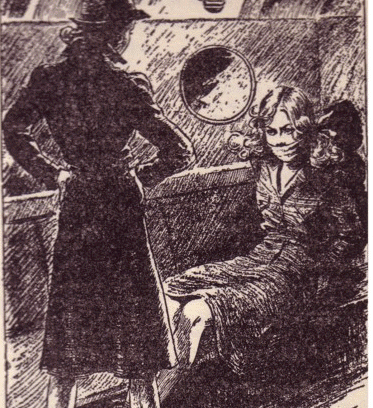
I'm not saying Nancy Drew was a lesbian. (Believe me, I still remember the pushback on our 2007 article, How Gay Were the Hardy Boys.) But the original Nancy Drew stories were written in 1930, and sometimes their outdated language creates a problem.
"Will you tell us why you came here, and promise never to divulge to a soul a word about this place?"
"I promise nothing," Nancy declared.
"What!" the men ejaculated in astonishment.
I hate it when that happens....
That's an actual quote from the 1933 edition of Password to Larkspur Lane. The language was updated in later decades, and most readers have never seen the original texts. But before Nancy even hooked up with her butch friend Bess Marvin, she'd enjoyed this strange adventure with a young femme named Helen Corning.
After Helen and Nancy Drew encounter a suspect, Helen gushes "I just hated the looks of that man. Let's think about something pleasant." And then...
The girls accordingly enjoyed themselves by admiring each other's dainty lingerie, choosing the stockings which would best match slippers and frocks, and so for a time forgot the mystery. Helen was in ecstasies over Nancy's powder blue evening gown...
And when Nancy finally sneaks into the bad guy's house, Helen actually kisses Nancy Drew.
"Good luck," she whispered.
I swear I'm not making this up! ("Helen kissed her chum," it says on page 173.) That's how mind-bogglingly innocent people were in 1933. Or... There's something else going on here.
Nancy even spends the night sleeping with Helen. And the next morning, when she tells Helen she has "an adventure" in mind — Helen can't wait....
She threw back the covers of the bed and began dressing rapidly. "Hurry up, Nancy," she cried gayly.
"Lead me to this adventure..."
And to hell with sleuthing!
Sorry, my mind wandered off there for a second. Or am I the only one who sees sexy lesbian bondage overtones in the 1930 frontispiece illustration for The Mystery at Lilac Inn? (See the picture above.) Even twenty years later, when the books were updated, Nancy Drew was still tied up at the hands of the domineering jewel thief Mary Mason.
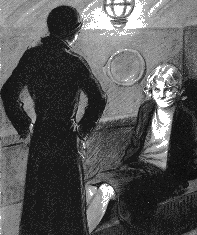
And then there's this 1939 scene from The Clue of the Tapping Heels.
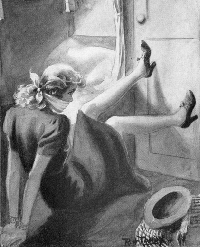
Though I've also had sexy lesbian bondage fantasies involving another Nancy...
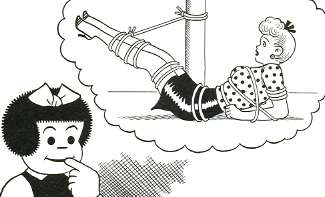
Still, I want to believe that even the most prudish reader would be curious about a chapter titled "The Man with the Whip." ("You saved me from a very unpleasant experience back there, Effie...") But the real moral of this story is that even in 1933, Nancy Drew kicked bad-guy ass.
"'Oh dear, this is something I don't know much about," the girl said in vexation. "How does one go about crippling an airplane motor?"
Maybe it helps to think of the books as antique children's pulp fiction...
A Little History
The first Nancy Drew books were action-packed adventure stories ghostwritten by the first woman ever to receive a masters of journalism from the University of Iowa in 1927. Mildred Wirt Benson (under the pen name "Carolyn Keane") still remains an unsolved mystery, but it's obvious that she lived in a different world. Benson practically fell through time, according to Wikipedia, living for 97 years, from 1905 to 2002. And though she didn't write Password to Larkspur Lane, she is responsible for the The Mystery at Lilac Inn, which is often cited for another unfortunate anachronism in the original Nancy Drew series — racism.
In fact, the book's first three chapters are all about Nancy trying to find a substitute housekeeper when her maid goes out of town, with Benson writing that there's a "slovenly colored woman" who Nancy rejects (along with an "Irish woman," and a "Scotch lassie.") And in a 1930 Benson book, The Hidden Staircase, she uses almost identical language to describe the villain's maid — a "fat, slovenly looking colored woman". When Nancy sneaks in through the cellar window — and accidentally makes a noise — she brings the villain's maid downstairs to investigate. And then the maid says....
"I done reckons my old ears is playing me false. I hears noises dat sounds like dey was in de basement and dey was only in my haid."
Yes, Benson writes the maid's dialogue with the same dialect throughout the book. Later Nancy sneaks into a room in the hallway, and the villain's pet parrot starts squawking. The maid comes running, and Nancy hides in the closet.
"How comes you so excited to-night, talkbird?" the woman demanded crossly. "You carries on like a fool with all yo' squawkin' and speechifyin'."
And when the cops finally come, the maid holds them off with a shotgun.
To be fair, it was a long time ago. When Applewood Books ultimately republished these original texts in 1991, they added a preface with some soul-searching, acknowledging that "Much has changed" in America. ("The modern reader may be delighted with the warmth and exactness of the language, the wholesome innocence of the characters...but just as well, the modern reader may be extremely uncomfortable with the racial and social stereotypes...")
No matter how ugly these scenes are, the preface concludes, "These books are part of our heritage. They are a window on our real past." And all of these books were eventually re-written, though even those changes offer their own cultural clues.
By the 1950s Mary Mason's simple getaway car had become an elaborate two-man submarine, and jewel thief Mary was transformed into a spy for a massive foreign espionage ring — presumably reflecting anti-communist Cold War tensions.
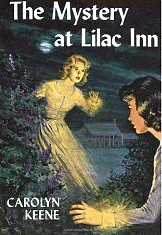
But the changes also stripped away much of the gritty personality from the characters, reducing them to the bland action-hero stand-ins we know today, and making them more suitable for an ongoing series of massively-franchised children's books. In the original books, the Nancy Drew character was much more realistic, which explains the impact she had on earlier generations. USA Today even reports that on the Supreme Court, all three female justices cite that original Nancy Drew as an influence — Sandra Day O'Connor, Ruth Ginsburg, and Sonia Sotomayor.
But now the updated characters are so insistently good, they almost dare readers to invent their own sexy subtexts. In one episode of That 70s Show, Jackie insists on reading a Nancy Drew mystery out loud during a sleep-over with her boyfriend. ("Dammit." says Kelso. "Why do I always have to Bess?") And in 2004 the commenters at Something Awful even submitted their own sexy re-imagined covers for both Nancy Drew and Hardy Boys books.
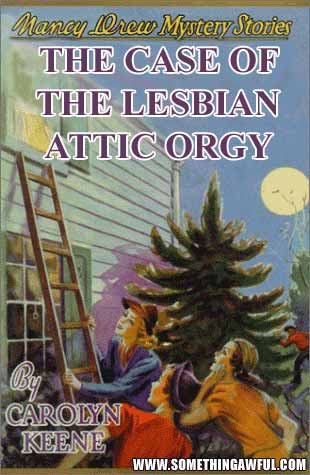
The world's changed a lot, even if Nancy Drew hasn't. (If Nancy Drew is a lesbian, don't tell Pamela Sue Martin. In 1978, when she was 25, the TV actress who'd played Nancy Drew in the 1970s did a naked pictorial in the prototypical men's magazine Playboy.) I want to believe modern Nancy Drew writers understood this secret intrigue when they created a 1995 TV version. Its last episode ends with Nancy abruptly breaking things off with her boyfriend Ned.
"He was right. Our relationship is a mystery. But it's the one mystery I can't seem to solve..."
This year marks the 80th anniversary of the very first Nancy Drew books. But it's important to remember that no matter how quaint she started out, every once in a while, even those original old-fashioned Nancy books would still blurt out something so surprisingly progressive and modern, it'd make you want to cheer. For example, in the 1933 book Password to Larkspur Lane, Nancy tells her friend Helen to wear hiking clothes, since they're sneaking through the woods. I think this should be hung over the arch at the Nancy Drew School of Business.
"We are going to use strategy, but not charm, so put that frilly frock away."
You go, girl!
Don't let anyone tell you how to behave — no matter what decade it is!
for Password to Larkspur Lane
Starting in 1992, Mabel Maney did lesbian camp re-imaginings of the Nancy Drew genre with the “Nancy Clue” books.
Nice post. I will call out one specific example, your first one, as particularly unfair, though. The usage of language changes over time. Specifically, before World War I, words like “ejaculate”, “erection”, “intercourse”, and so on, could be used freely, without the assumption that the reader would infer a double entendre. Paul Fussel, in his book The Great War and Modern Memory, talks about this in some detail. Given that the Nancy Drew books were written by a woman from Iowa, less than a generation removed from the War and half a world away from the (then) literary center of the English world, it’s not surprising that she might still be using words such as that un-ironically.
I know you just wanted to start the article off with a bang, so to speak, but I think this is a particularly clear example of the dangers of reading a text with modern eyes.
Bess was Nancy’s wimpy feminine friend– the butch one was George Fayne.
What a SLUT!
Just a quick word for Destiny, the author of this article:
Concerning what I’d like to call the Nancy Drew triumvirate, Bess Marvin was the plumpish, feminine one; it was George who was her tomboyish buddy. Can’t recall George’s surname at the moment. I dearly hope that I wasn’t the only Nancy Drew aficionado to draw this to your attention.
I had tried to recreate the villain of The Mystery of Lilac Inna s a lesbian aggressor. Furthermore, I wrote several “Nancy Drew mysteries with a crossover to Lovecraft horror.
Nancy, you ignorant slut! Who did you have to sleep with to get this published?
I’ve only read two Nancy Drew books, one my mum picked up for me at Value Villiage about Nancy and the Hardy boys sonlvig some mystery in Australia with the Maori peoples and the other that came with one of the computer games about antiques of some sort. I love Nancy’s feminine intuition. It’s like Spidey-sense. My mum was all about the kid’s mysteries with Trixie Belden and the Bobsy twins and stuff. Plus all those books about nurses who end up sonlvig mysteries in each book (she’s a nurse herself). Cherry Ames is my hero.Speaking of the computer games, they rock. Not only are they challenging, but they teach you things like Mayan numbers, electric rewiring, Spanish, stenography and French Revolution history. Plus, if you get stuck you can call George or Bess (who are ALWAYS having a sleepover the weekend you’re away) or Ned or the Hardy Boys and sometimes Hannah. Just make sure you don’t accidently: get trapped in an ancient Mayan mummy’s tomb, burn to death, freeze to death, get trapped in a broken elevator, fail to defuse a bomb, step on a loose board or get run over by a rogue roller coaster. Word.
Pass the Maney “Nancy Clue” books by, they get worse with each one. If you want a GOOD Nancy Drew lesbian story, it’ll have to come from fanfics.
Nancy Drew was always somewhat feminist in that it’s about teen girls getting it done, often in the face of ridicule. The old 30’s movies also have some parts that wouldn’t be seen today like comic Willie Best as a handyman who steals and cooks a chicken for lunch or “Ted” (not Ned on film) borrowing a pistol from his uncle (the horror!) so Nancy can check how far a spent cartridge flies to see if a suicide may be murder. The police show up and (IIRC) there’s no problem of a teen having a pistol just that he shot a sign in a no hunting area. Today it would be a SWAT team response and likely a DCF intervention instead of a lecture.
Based upon the first few books’ 1959 & 1960 revisions, I Googled to see if Helen Corning had been gay/bi-coded and ran into a Tumblr post with a line that popped right out in the photo: ““I–I–” began Helen, but Nancy leaned in and choked her off with a kiss.”, which got me wondering about Nancy. Glad I found this page (THANK YOU! ❤️), since none of the Wikis and such seem to even mention the topic.
I checked the 1933 version of book #10 “The password to Larkspur Lane”: it’s a legit excerpt in the photo (assuming that the .pdf is faithful to the hardcopy), but had it been fanart or something, I’m clearly not the only one to have wondered; funny thing is that the 1966 revision “accidentally” stripped that line right out…
In one book I read, Nancy gets a flat tire and spends a page changing it. Then she continues on her trip. I asked my mother why that was even there because it did nothing for the plot. “To show Nancy is self sufficient and not a damsel in distress.” From that point on I was imagining Nancy as being strong and resourceful, and poor Ned not knowing which end of the tire iron was up. Poor Ned. Always on the bottom, with duct tape over his mouth.